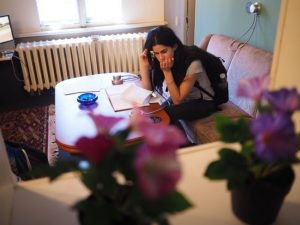Rose Marie Beck
In July 2017 the Institutes of African Studies, Anthropology and Cultural Studies organized the summer school “Seeing the Self through the Lens of the Other”. What stands out in hindsight is how strongly we resisted seeing ourselves through that lens, how consequently we refused to accept ascriptions of others about us. I kept wondering why this is so?
On the second day of the summer school we went to the exhibition #Prolog1-10 at the Japanese Palais in Dresden. One stage of the exhibition, #Prolog7, drew our attention: A living room, sofa set, table, built-in shelves, a fridge, a Qur’an and prayer rug, some pictures on the walls. A very modest, rather run down and ‘vintage’ place. Syrian men’s voices from recorders that told their stories of their encounters with Germans and Germany, with a coffee machine, the fridge, the tram, the people. We were not altogether clear what it was supposed to be: a German living room? A migrants’ living room in Germany?

The #Prolog7’s website says this:
What is the meaning of „we“ and the discourse about the „other“ in a museum for world cultures? From which perspective does the museum speak? What is the Saxon culture? Are there truly “collective” cultures? „We?“ – the result of a study that worked with and among fugitives – has taken place over the past months in cooperation with the Umweltzentrum Dresden. „We?“ is a living room where the visitor can see and hear stories, fragments of observations of Saxon rituals, experiences, and places. It is a collage of anecdotes, stereotypes, experiences, misunderstandings, and curiosities. „We?“ tells of the encounter of fugitives with a new society.
“But this could also be a living room in Greece from the 1960s”, said one student from Greece. “Or it could be a living room from Brazil from the 1970s”, said the student from Brazil. “This could also be is a working-class living room from the GDR”, I said.
“But this is not us”, we all agreed. This part of the exhibition has miserably failed, we declared. Poorly made, poor concept, poor museology.
Yet maybe it has not. Maybe that’s what it is all about. What would it mean to accept that this is how “we” are being seen by fugitives? To see how we are seen through the eyes of others might not be pleasant. Not only because they see us in a particular way, but because we do not recognize ourselves. Sara Hartmann, who was part of a round table discussion during the summer school, impressively demonstrated in her short stories what other-ascription means for minor unaccompanied asylum seekers: You have to tell your story, however grim, in a way that the asylum granting institution can understand. You can’t choose not to tell it, nor to tell it in a way that you can sustain. It is a matter of survival to be able to narrate your life on their terms. Even if you do no longer recognize yourself. Trouble and trauma have already excruciatingly transformed you, now even you yourself do no longer recognize yourself. Even your name may be misspelled. What then, is left of you?
We – in the north, if I am allowed to say that – have the resources and the power to reject such ascriptions. We – If there exists such a thing – seem to have the weight of deprovincialized history, the privilege of confidence, to insist on voice and coherence of the self. Yet the shame of being distorted beyond recognition is an existential normality, however painful, for more people than we are prepared to accept.
